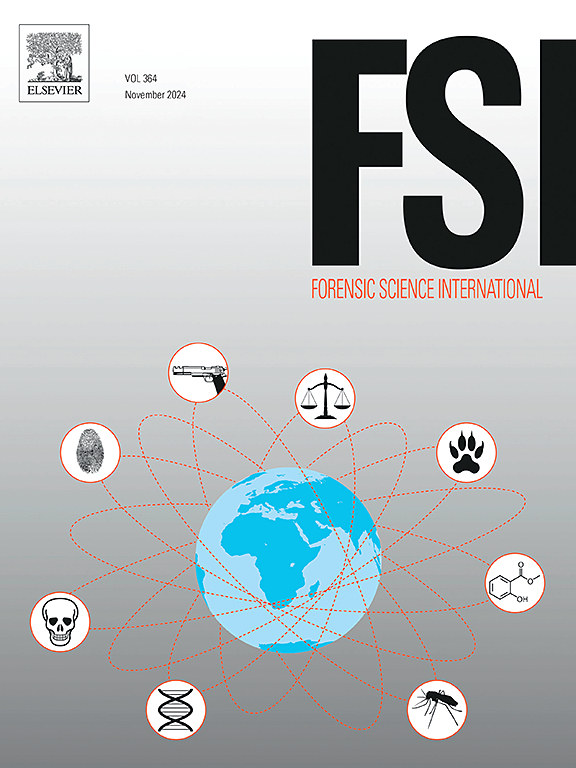如何保存提取后留下的骨粉,以便将来进行分析
IF 2.5
3区 医学
Q1 MEDICINE, LEGAL
引用次数: 0
摘要
适当的储存条件对保存DNA很重要。骨骼通常在- 20°C下长期保存。当从骨骼中分离DNA时,获得的骨粉不会被完全消耗。提取DNA后留下的骨粉在- 20°C下保存10年,为将来的DNA分析提供了价值。由于在冰箱中长期储存价格昂贵且需要大量空间,我们对骨粉是否也可以在室温下储存而不影响DNA的保存很感兴趣。为了探索这一点,研究人员选择了21块产生完整短串联重复序列(STR)图谱的二战时期骨骼,并将它们的骨粉储存在冰箱和室温下长达3年。每年之后,从储存的骨粉样本中提取DNA并进行分析。DNA提取采用全脱矿法,采用商业法医EZ1 &;EZ2 DNA调查员提取试剂盒(Qiagen),在EZ1 Advanced XL机器(Qiagen)上进行自动DNA纯化。采用实时荧光定量PCR法测定DNA的数量和质量。通过测定DNA的数量、降解率以及保存3年后STR基因分型的成功率来评估不同储存条件对DNA保存的影响。所获得的结果表明,在冷冻和室温下储存的样品中,DNA的数量和降解率没有差异。此外,无论样品是在室温下保存还是冷冻保存,所有样品在保存3年后都获得了信息丰富的STR谱。结果表明,骨粉不需要冷冻长期储存,可以节省冷冻室空间,降低成本。本文章由计算机程序翻译,如有差异,请以英文原文为准。
How to store the bone powder left after extraction for future analysis
Proper storage conditions are important for preservation of DNA. Bones are usually stored long term at −20 °C. When isolating DNA from bones, the bone powder obtained is not fully consumed. The value of retaining bone powder left after extracting DNA for future DNA analysis has been confirmed after storing bone powder for 10 years at −20 °C. Because long-term storage in a freezer is expensive and requires significant space, we were interested in whether bone powder could also be stored at room temperature without affecting the preservation of DNA. To explore this, 21 Second World War bones that generated full short tandem repeat (STR) profiles were selected, and their bone powder was stored in a freezer and at room temperature for up to 3 years. After each year, the DNA was extracted and analyzed from the stored bone powder samples. DNA was extracted using the full demineralization method employing a commercial forensic EZ1 & EZ2 DNA Investigator extraction kit (Qiagen), and automated DNA purification was performed in an EZ1 Advanced XL machine (Qiagen). Real-time PCR quantification was employed to determine the quantity and quality of DNA. The effect of different storage conditions on preservation of DNA was evaluated by determining the amount of DNA, its degradation rate, and after 3 years of storage also the success of STR genotyping. The results obtained showed no difference in the amount of DNA and degradation rate between samples stored in a freezer and at room temperature. In addition, highly informative STR profiles were obtained from all samples after 3 years of storage, regardless of whether they were stored at room temperature or were frozen. The results show no need for freezing bone powder for long-term storage, which makes it possible to save space in freezers and reduce costs.
求助全文
通过发布文献求助,成功后即可免费获取论文全文。
去求助
来源期刊

Forensic science international
医学-医学:法
CiteScore
5.00
自引率
9.10%
发文量
285
审稿时长
49 days
期刊介绍:
Forensic Science International is the flagship journal in the prestigious Forensic Science International family, publishing the most innovative, cutting-edge, and influential contributions across the forensic sciences. Fields include: forensic pathology and histochemistry, chemistry, biochemistry and toxicology, biology, serology, odontology, psychiatry, anthropology, digital forensics, the physical sciences, firearms, and document examination, as well as investigations of value to public health in its broadest sense, and the important marginal area where science and medicine interact with the law.
The journal publishes:
Case Reports
Commentaries
Letters to the Editor
Original Research Papers (Regular Papers)
Rapid Communications
Review Articles
Technical Notes.
 求助内容:
求助内容: 应助结果提醒方式:
应助结果提醒方式:


